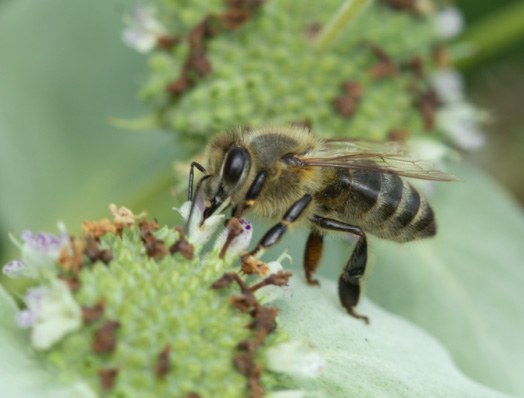Posted: July 29, 2020
Pennsylvania is home to over 430 species of bees each with their own unique traits and characteristics. In this Webinar, Dr. Margarita López-Uribe discusses the biodiversity of Pennsylvania bees and offers tips to identify major groups of bees based on their morphological traits.

Learn about the biodiversity of Pennsylvania bees with Dr. Margarita López-Uribe.
Bees are grouped into seven families: Melittidae, Andrenidae, Halictidae, Stenotritidae, Colletidae, Megachilidae, and Apidae. Pennsylvania has a very high diversity of bees with six of the seven families found in the state. The family Stenotritidae is the only one not present in Pennsylvania since these bees are only found in Australia. Getting to know these bees provides us with information on several unique morphological traits and behaviors of each of these groups.
The first family discussed is the family Melittidae or "melittid bees." Bees in this family have small to mid-sized bodies and like most bees, they live a solitary lifestyle and nest underground. They are also univoltine meaning that they only produce one generation per year. As oligolectics, these bees specialize in the pollen collection of a few host plants. A distinguishing morphological trait that these bees have is a pair of grooves on their face with one groove below each antenna. Both males and females have this trait but only males have a section of yellow on their faces while the females do not. The second family presented is the family Andrenidae also known as "mining bees." Mining bees get their name from the fact that they build tunnels underground where they will create provisioning cells and lay their eggs. These bees share many of the same traits as melittid bees. Bees in both of these families are small to mid-sized, solitary, nest underground, and univoltine. Many Andrenidae bees are also oligolectic but not all of them. Some species of bees within this family are polylectic, meaning that they collect pollen from many different types of plants.
The third family discussed includes the commonly called "sweat bees" group in the family Halictidae. These bees receive this name because they are attracted to the salts in sweat. This family of ground-nesting bees has high variation in social interactions, with species ranging from solitary to social. Sweat bees can be either oligolectic or polylectic and can also be either univoltine or multivoltine. Multivoltine bees produce more than one generation of bees in a year versus univoltine which only produces one. Some bees in family Halictidae are also commonly known as "green bees" including bees in the genera Agapostemon spp., Augochlorella spp., Augochloropsis spp. and Augochlora spp. The family Colletidae contains both "cellophane bees" and "masked yellow bees". Bees in this family are mid to large sized, solitary, univoltine, oligolectic and polylectic, and nest either underground or in twigs. Cellophane bees earn their name from the fact that they line their brood cells in cellophane. Cellophane bees also have a bifid tongue and diagonal eyes. The term "masked bees" is due to the yellow "mask" present on some bees' faces.
The family Megachilidae contains "leafcutting bees" and "mason bees" and vary from small to large sized, and oligolectic to polylectic. However, all species are solitary, and most nest in hollow twigs and stems. These bees build their provision cells one by one and earn their respective names through the materials they build their cells out of. Finally, we discuss the largest family of bees in Pennsylvania: family Apidae. This family includes the most well-known species of bees such as honey bees, bumble bees, carpenter bees, squash bees, etc. These bees are very diverse and range in size, social behavior, reproductive behavior, and nesting behavior.
The publication of an updated checklist of the bees of Pennsylvania collected data on all records of bees reported in the state This study revealed that 13% of the species have not been reported in Pennsylvania since the year 2000. For example, species such as Colletes productus, Epeoloides pilosulus, and Colletes aestivalis have not been reported in the state for more than 100 years. However, the species C. aestivalis was just reported a few weeks ago in York County, PA in the backyard of a gardener. This event highlights the importance of home gardens in supporting native bee populations. The best way to fight against the decline in bee populations is to plant more flowers, allow lawns to have weeds, twigs, and other nesting site substrates, reduce pesticides as much as possible, and advocate for policies to reduce the effects of climate change. To learn more about bee biology and bee health check out previous webinars and sign up for the final one!
Written by Ashley Moak
Full webinar descriptions and registration information
For additional questions you can contact Dr. López-Uribe
www.lopezuribelab.com , @mmlopezu
Additional Resources:
- Bees of Pennsylvania
- Discoverlife Website
- The Bees of Your Backyard: A Guide to North America's Bees book by Wilson, Joseph S., and Messinger Carril, Olivia J

